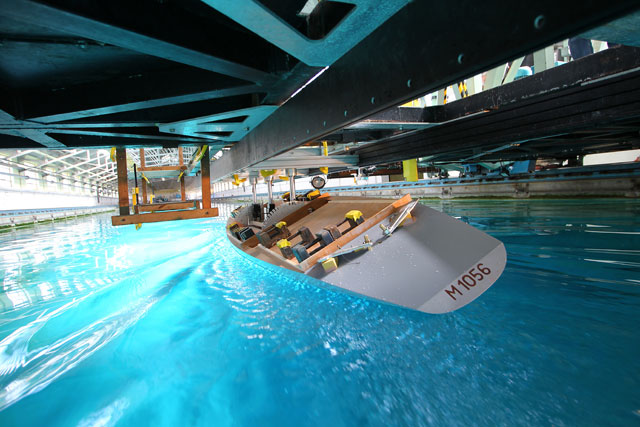
Racing aficionados among you are, no doubt, intimately familiar with Ranger. For those who don’t know the racing world, the 135-foot Ranger was one of the most famous J-Class yachts ever to hit the water, built for American railroad executive and yachtsman Harold S. “Mike” Vanderbilt by Bath Iron Works. W. Starling Burgess and Olin Stephens II collaborated on her design; in fact, it took tests of seven different hull shapes, conducted at the famed Stevens Institute, before the designers found the combination of elements they felt would make her the ultimate racer.
Ranger’s keel was laid in late 1936, and when the yacht, a.k.a. Bath Iron Works Hull #172, launched in spring 1937, she was ready to take on the competition at the America’s Cup. And take them on she did. She successfully defeated the Cup that year against Endeavour II, the British challenger – handily winning by two miles in race one of the four-race event, in fact.
Sadly, Ranger was hauled at the end of 1937 and was sold for scrap in 1941. She was also the last J-Class yacht to defend the Cup. But on a positive note, she marked Sparkman & Stephens’ entry into America’s Cup racers. And she’s inspired the famed design firm to develop a new 135-foot “Super-J,” seen above, for a J-Class devotee.
The devotee in question didn’t specifically tell Sparkman & Stephens’ designers that Ranger should be the base model for his boat. Rather, the firm researched every J-Class hull – ones brought to life and left on paper – in its library, to determine which one to use. (On a side note, if you ever get the chance to visit Sparkman & Stephens’ headquarters in New York City, do so; the number of designs it has fills drawer after drawer, a nautical-history buff’s delight.) After extensively evaluating the pros and cons of all the designs, in combination with construction methods that would produce a spirited performer, the team decided that Ranger’s lines stood above the rest.
The new Super-J should make her predecessors proud: She’s being built via cold-molded construction, with the wood fastened to stainless steel frames. Her low-profile deckhouse will keep the working deck unobstructed, and in combination with her helm pedestal plus 20 stainless steel Dorade vents, she should look like she stepped from the pages of history. The Super-J will have a 15-foot draft and 21-foot beam, with a displacement of 177 tons.
Although she’ll feature modern mechanical systems, they’re being chosen as much for their light weight, to maximize ballast, as they are for technology. High-modulus carbon-fiber spars, 16 hydraulic winches, four coffee grinder pedestals (typically in the middle of the cockpit on a racer), and a hydraulic mainsheet traveler should convince the competition at regattas that the Super-J means business.

When the races are over, or perhaps between regattas, the Super-J will treat eight guests to a modern layout, also being designed by Sparkman & Stephens. Besides featuring a full-beam master suite plus three guest staterooms, the yacht will include a bar area, open to the main saloon (see illustration). Eight crew will attend to the owner’s and guests’ needs, besides work the deck.
While a launch date has not been announced, it stands to reason that this Super-J will compete alongside other J-Class re-creations in the coming years, at races like The Superyacht Cup and the Loro Piana Superyacht Regatta. If she does, imagine the excitement that will result if she goes head-to-head with the 138-foot Hanuman – a.k.a. a modern version of Endeavour II.
The late Olin Stephens is probably smiling at the very thought of history repeating itself.









Leave a Reply